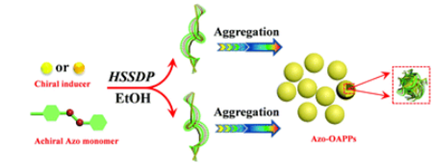Welcome to College of Chemistry, Chemical Engineering and Materials Science of Soochow
University
The construction of photoresponsive polymer particles with supramolecular helicity from achiral monomers by helix-sense-selective polymerization
Xiaoxiao Cheng, Tengfei Miao, Haotian Ma, Lu Yin, Wei Zhang*(张伟), Zhengbiao Zhang and Xiulin Zhu
Suzhou Key Laboratory of Macromolecular Design and Precision Synthesis, Jiangsu Key Laboratory of Advanced Functional Polymer Design and Application, State and Local Joint Engineering Laboratory for Novel Functional Polymeric Materials, College of Chemistry, Chemical Engineering and Materials Science, Soochow University, Suzhou Industrial Park, Suzhou 215123, China.
Polym. Chem., 2020, 11, 2089--2097
The induction of supramolecular chirality from achiral azobenzene-containing polymers has been widely investigated in solution and in the film state. However, the construction of micron-sized optically active azobenzene-containing polymer particles (Azo-OAPPs) with supramolecular chirality in heterogeneous systems has not yet been demonstrated. Here, Azo-OAPPs were successfully prepared from achiral Azocontaining monomers for the first time by helix-sense-selective dispersion polymerization (HSSDP), also known as asymmetric helix-chirogenic polymerization. The trans-Azo units in the polymer side chains constituting the OAPPs adopt supramolecular helical structures with preferential screw sense, and thus the OAPPs have remarkable chiral properties. The Azo-OAPPs in an ethanol dispersion were characterized by CD and UV-vis spectroscopy, and this demonstrated the successful transfer of chirality from the chiral octanol molecules to the polymer particles during HSSDP. In addition, the supramolecular chirality of the Azo-OAPPs could be easily controlled by adjusting the volume of chiral solvent, polymerization time and UV light irradiation time. The morphologies and sizes of the Azo-OAPPs were investigated by TEM and DLS studies. Moreover, a supramolecular helical system in which covalent bonds were introduced into the Azo-OAPPs using a divinylbenzene (DVB) crosslinker was also investigated. Interestingly, the chirality of the crosslinked Azo-OAPPs demonstrated improved UV-resistance compared with the non-crosslinked counterparts. The present study develops a novel strategy for preparing Azo-OAPPs with supramolecular chirality from an achiral source, which is expected to find potential applications in chiroptical materials.

链接:https://pubs.rsc.org/en/content/articlelanding/2020/py/c9py01868a#!divAbstract